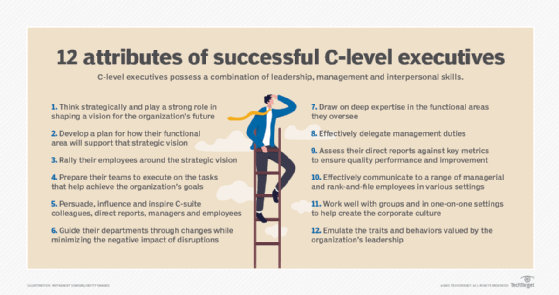What is a CVO (chief visionary officer)?
The CVO (chief visionary officer) is a newer C-suite title where the holder is expected to have a broad and comprehensive knowledge of all matters related to the business of the organization, as well as the vision required to steer its course into the future.
CVO is being used in corporations to differentiate the holder from other corporate executives, including the chief executive officer, or CEO; chief financial officer, or CFO; chief information officer, or CIO; and chief technology officer, or CTO.
Sometimes, the title of CVO is used to denote authority over high-ranking executives like the CEO. In other cases, the person who holds the CVO title also holds other titles and will list them together.

The history of the chief visionary officer
The origins of the CVO role have been attributed to two individuals, each of whom brought unique perspectives to this emerging C-suite title: Tim Roberts and Einar Stefferud.
Tim Roberts
Tim Roberts, the founder of Broadband Investment Group in the 1990s, is often credited as one of the first to use the CVO title. Roberts said he created the title to define a role that was superior to the CEO and recognized the visionary qualities necessary to guide a complex organization with diverse operations.
For Roberts, the CVO designation reflected his focus on setting a forward-looking strategic direction for the company, integrating various aspects of the business and emphasizing the importance of innovation in decision-making. He did not originally intend for the title to gain widespread adoption across the corporate world, but sought to emphasize the unique strategic role it played within his organization.
Einar Stefferud
Einar Stefferud, co-founder of First Virtual Holdings, an early internet payment company, is also widely recognized as the first person to hold the title of CVO. Stefferud's adoption of the title in 1994 stemmed from his role in shaping the company's strategic vision and navigating the uncharted waters of digital commerce during the nascent days of the internet.
His pioneering work in electronic communications and secure online payments showcased the forward-thinking approach associated with the CVO role. While Roberts is credited with defining the CVO as a role above the CEO, Stefferud's early adoption of the title in a groundbreaking industry provides a compelling argument for his recognition as the first CVO.
Both individuals played pivotal roles in shaping the perception and responsibilities of this visionary executive position, which has since proliferated across industries as organizations prioritize innovation and long-term strategy. Since then, however, the CVO role has evolved, gaining traction in industries where innovation and long-term strategic thinking are critical, such as technology, media and sustainability.
Attributes to look for in a CVO
A CVO is a forward-thinking leader who plays a critical role in defining and steering an organization's long-term vision and strategy. To excel in this role, a successful CVO should possess the following attributes:
- Exceptional visionary thinking. The ability to anticipate market trends, technological advancements and societal changes to shape the organization's future trajectory.
- Strategic foresight. Expertise in identifying opportunities and threats in dynamic markets and devising strategies to navigate them effectively.
- Innovative leadership. A creative approach to problem-solving and decision-making that inspires teams to think outside the box and embrace transformative ideas.
- Strong communication skills. The capability to articulate a compelling vision and rally internal and external stakeholders around a shared purpose.
- Cross-functional collaboration. Proficiency in working across departments to foster alignment and collaboration, ensuring every team contributes to the organization's overarching goals.
- Adaptability and resilience. The flexibility to pivot strategies in response to evolving market demands while maintaining focus on long-term objectives.
- Cultural influence. The ability to shape and sustain an organizational culture that values innovation, inclusivity and continuous improvement.
Organizational goals a CVO can help businesses achieve
Organizations, from startups to enterprises, can benefit from bringing on a CVO to help achieve specific high-level goals. These include but are not limited to the following:
- Driving digital transformation. Guiding organizations through the adoption of new technologies and processes to improve efficiency, customer experience and market positioning.
- Maintaining competitive advantage. Developing forward-thinking strategies that position the organization as a leader in its industry, even in rapidly changing markets.
- Facilitating major structural changes. Providing strategic guidance during significant organizational transitions, such as mergers, acquisitions or restructurings.
- Managing rapid growth. Helping organizations scale operations, culture and infrastructure effectively during periods of accelerated expansion.
- Fostering innovation. Cultivating an environment where new ideas are encouraged and pursued, leading to the development of cutting-edge products, services or business models.
By combining these attributes and objectives, a chief visionary officer not only helps organizations adapt to an ever-changing business landscape, but also ensures they remain forward-looking and strategically positioned for success.

CVO vs. CEO: What's the difference?
While the CEO focuses on the execution of a company's strategic plan, the CVO is tasked with defining and communicating the long-term vision. The CEO often manages day-to-day operations, financial decisions and stakeholder relations, while the CVO serves as a thought leader who identifies opportunities for growth and innovation.
The CEO and CVO roles might overlap in smaller organizations, but in larger companies, the CVO typically works alongside the CEO to ensure alignment between visionary goals and operational execution. This partnership ensures short-term performance objectives are achieved without compromising the company's overarching mission.
Other C-level titles
In addition to those mentioned above, other commonly used C-suite job titles include chief marketing officer, or CMO; chief operating officer, or COO; and chief data officer, or CDO. However, organizations continue to invent new corporate titles at an increasing rate. Examples include chief strategy officer, or CSO; chief scientific officer; chief product officer, or CPO; and chief people officer.
Daniel Quinn Mills, a professor of business administration at Harvard Business School, claims that the proliferation of new titles is being used to attract and retain employees by offering them status -- which is free -- rather than money.
This trend reflects the increasing complexity of modern business operations, where specialized roles are necessary to address specific organizational needs, such as a chief digital officer for digital transformation or a chief sustainability officer for sustainability.
Industries that benefit from a CVO
Certain industries are particularly well suited for the inclusion of a CVO due to their reliance on innovation and forward-thinking strategies, such as the following:
- Technology companies leverage CVOs to identify disruptive technologies and shape product roadmaps that align with future market demands.
- Media organizations use CVOs to adapt to evolving consumer preferences and emerging content distribution channels.
- Sustainability-focused companies rely on CVOs to integrate environmental, social and governance considerations into long-term strategic planning.
In each of these sectors, the CVO ensures the organization remains adaptable and aligned with long-term trends while maintaining its competitive edge.
The future of the chief visionary officer role
As the pace of change accelerates in global markets, the demand for visionary leaders is expected to grow. Future CVOs will likely be equipped with advanced data analytics tools and AI-driven insights to make more informed decisions about the direction of their organizations. Additionally, the role might expand to include greater involvement in corporate social responsibility and sustainability initiatives.
The evolution of the CVO position underscores the importance of strategic vision in a rapidly changing business environment. Organizations that embrace this role are more likely to stay ahead of the curve and thrive in uncertain markets.
CIOs must work with other C-level executives to lead transformation and meet business goals. With an ever-expanding C-suite, the possibilities for collaboration are endless. Learn about overlooked relationships CIOs should build within the C-suite. Also, explore steps to create a CIO-CEO strategic partnership.







